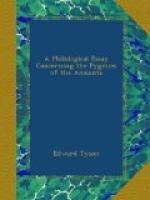[Footnote A: Quoted by Keightley, p. 62.]
[Footnote B: Grimm ap. Keightley, p. 230.]
[Footnote C: Keightley, p. 92, quoting from Thiele.]
[Footnote D: Folk Lore Journal, v. 143.]
[Footnote E: Tregear, Journ. Anth. Inst., xix. 121.]
7. The association of little people with water as a home is a widespread notion. The Sea-Trows of the Shetlanders inhabit a region of their own at the bottom of the sea. They here respire a peculiar atmosphere, and live in habitations constructed of the choicest submarine productions. They are, however, not always small, but may be of diverse statures, like the Scandinavian Necks. In Germany the Water-Dwarfs are also known. At Seewenheiher, in the Black Forest, a little water-man (Seemaennlein) used to come and join the people, work the whole day along with them, and in the evening go back into the lakes.[A] The size of the Breton Korrigs or Korrigan, if we may believe Villemarque in his account of this folk, does not exceed two feet, but their proportions are most exact, and they have long flowing hair, which they comb out with great care. Their only dress is a long white veil, which they wind round their body. Seen at night or in the dusk of the evening, their beauty is great; but in the daylight their eyes appear red, their hair is white, and their faces wrinkled; hence they rarely let themselves be seen by day. They are fond of music, and have fine voices, but are not much given to dancing. Their favourite haunts are the springs, by which they sit and comb their hair.[B] The Maories also have their Water-Pigmies, the Ponaturi, who are, according to Mr. Tregear, elves, little tiny people, mostly dwellers in water, coming ashore to sleep.[C] “The spirits most commonly met with in African mythology,” says Mr. Macdonald, “are water or river spirits, inhabiting deep pools where there are strong eddies and under-currents. Whether they are all even seen now-a-days it is difficult to determine, but they must at one time have either shown themselves willingly, or been dragged from their hiding-places by some powerful magician, for they are one and all described. They are dwarfs, and correspond to the Scottish conception of kelpies or fairies. They are wicked and malevolent beings, and are never credited with a good or generous action. Whatever they possess they keep, and greedily seize upon any one who comes within their reach. ’One of them, the Incanti, corresponds to the Greek Python, and another, called Hiti, appears in the form of a small and very ugly man, and is exceedingly malevolent’ (Brownlee). It is certain death to see an Incanti, and no one but the magicians sees them except in dreams, and in that case the magicians are consulted, and advise and direct what is to be done."[D]




